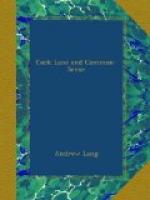One of the earliest references to Scotch second sight is quoted by Graham Dalyell from Higden’s Polychronicon (i. lxiv.). {231a} ’There oft by daye tyme, men of that islonde seen men that bey dede to fore honde, byheded’ (like Argyll, in 1661), ’or hole, and what dethe they deyde. Alyens setten theyr feet upon feet of the men of that londe, for to see such syghtes as the men of that londe doon.’ This method of communicating the hallucination by touch is described in the later books, such as Kirk’s Secret Commonwealth (1691), and Mr. Napier, in his Folklore, mentions the practice as surviving in the present century. From some records of the Orkneys, Mr. Dalyell produces a trial for witchcraft on Oct. 2, 1616. {231b} This case included second sight. The husband of Jonka Dyneis being in a fishing-boat at Walls, six miles from her residence at Aith, and in peril, she was ’fund and sein standing at hir awin hous wall, in ane trans, that same hour he was in danger; and being trappit, she could not give answer, bot stude as bereft of hir senssis: and quhen she was speirit at quhy she wes so movit, she answerit, “Gif our boit be not tynt, she is in great hazard,”—and wes tryit so to be’.
Elspeth Reoch, in 1616, was tried as a witch for a simple piece of clairvoyance, or of charlatanism, as we may choose to believe. The offence is styled ‘secund sicht’ in the official report. Again, Issobell Sinclair, in 1633, was accused, almost in modern spiritualistic phrase, of ’bein controlled with the phairie, and that be thame, shoe hath the second sight’. {232a} Here, then, we find it officially recorded that the second-sighted person is entranced, and more or less unconscious of the outer world, at the moment of the vision. Something like le petit mal, in epilepsy, seems to be intended, the patient ‘stude as bereft of hir senssis’. {232b} Again, we have the official explanation of the second sight, and that is the spiritualistic explanation. The seer has a fairy ‘control’. This mode of accounting for what ‘gentle King Jamie’ calls ‘a sooth dreame, since they see it walking,’ inspires the whole theory of Kirk (1691), but he sees no harm either in ’the phairie,’ or in the persons whom the fairies control. In Kirk’s own time we shall find another minister, Frazer of Tiree, explaining the visions as ‘revived impressions of sense’ (1705), and rejecting various superstitious hypotheses.
The detestable cruelty of the ministers who urged magistrates to burn second-sighted people, and the discomfort and horror of the hallucinations themselves, combined to make patients try to free themselves from the involuntary experience. As a correspondent of Aubrey’s says, towards the end of the sixteenth century: ’It is a thing very troublesome to them that have it, and would gladly be rid of it . . . they are seen to sweat and tremble, and shreek at the apparition’. {232c} ’They are troubled for having it judging it a sin,’ and they used to apply to the presbytery for public prayers and sermons. Others protested that it was a harmless accident, tried to teach it, and endeavoured to communicate the visions by touch.




